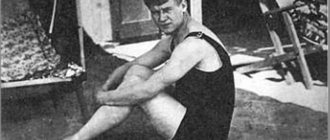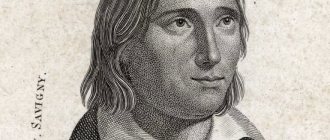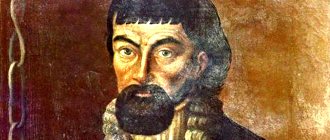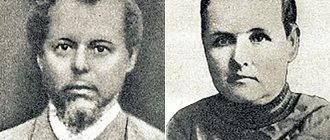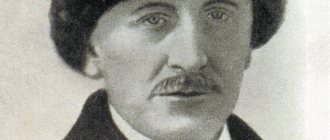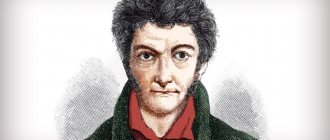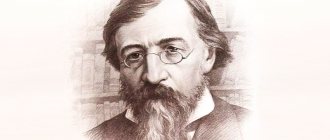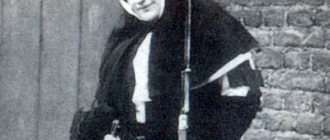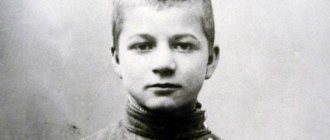early years
The exact date of birth of Svyatoslav is unknown. It is believed that the prince was born between 930 and 942, with historians giving preference to the second date. Svyatoslav's father was Prince Igor, the son of the famous Rurik, the first prince of the ancient Russian state. Mother - Princess Olga, who went down in history as the first ruler of Rus' to convert to Orthodoxy.
Svyatoslav lost his father early - Igor died in 945 while collecting tribute from the Slavic tribe of the Drevlyans. According to the chronicles, the reason for the Drevlyan attack on Igor was the exorbitant tribute that the Kiev prince imposed on his Slavic neighbors. Immediately after the death of his father, the young prince became the formal ruler of the state, but in fact his mother, Princess Olga, had power.
Most of the prince's life was spent on military campaigns. According to legend, already at the age of 3 Svyatoslav took part in the famous campaign against the Drevlyans. Princess Olga, wanting to take revenge on the Drevlyans for the murder of her husband, went with an army to their capital Iskorosten. During this campaign, the young Svyatoslav made a symbolic throw of a spear towards the enemies, thereby announcing the beginning of the battle. Since then, war has become a common thing for the prince.
Prince's reign
As Svyatoslav grows up, he begins to take more and more part in government affairs. However, during his mother’s life, he was reluctant to deal with the administrative affairs of the principality, paying more attention to military campaigns. And there was a great need for this. The Russian state was surrounded by three main geopolitical rivals:
- Byzantine Empire;
- Khazar Khaganate;
- Bulgarian kingdom.
In addition, on the borders of the Kyiv principality lived numerous uncontrolled tribes of Slavs and other nationalities, which Kyiv tried to subjugate. One of these was the Vyatichi tribe.
First campaigns
The vast territories of the Vyatichi extended along the eastern border of the Principality of Kyiv, in the area of the upper reaches of the Oka and Desna rivers to modern Ryazan in the East. The main occupation of the Vyatichi was hunting and gathering (mushrooms, berries). Agriculture began to develop. Fur, which was obtained by Vyatichi hunters, served as the main commodity for trade.
The prince began his campaign against the Vyatichi in 964. This choice was not accidental. The Vyatichi paid tribute to another major rival of the Rus - the Khazar Kaganate. And the desire to wrest the Vyatichi from the control of the Khazars was quite natural. In addition, beyond the lands of the Vyatichi in the east was the territory of the Volga Bulgaria, also tributaries of the Khazar Kaganate. The Bulgars controlled the trade route along the Volga and could obstruct Russian merchants.
Russian chronicles do not preserve any special evidence of the results of these campaigns. It is only known that the Vyatichi stopped paying tribute to the Khazars, but this happened after Svyatoslav’s conquest of the Kaganate. As for Volga Bulgaria, the stories of Arab chroniclers indicate that this land was subjected to devastation and ruin. However, the Bulgar state itself survived and existed for several more centuries.
Most historians agree that these first campaigns were a preliminary stage to a more important future war with the Khazar Khaganate.
War with the Khazars
The Khazar Khaganate, which occupied a vast territory from the foothills of the Caucasus in the south to the Volga-Don interfluve in the north , was a long-time enemy of the Russian principality . By the middle of the 10th century, the Khazar Kaganate no longer had the greatness that once made the inhabitants of its neighboring countries tremble. On the contrary, Islamic influence actively penetrated into the Kaganate from the south and east, undermining the foundations of the Khazar statehood.
Svyatoslav began his campaign against the Khazars around 965. Historians do not agree on the exact date. It is believed that one of the reasons for the war was the request of the Byzantine Empire, which was also in a state of hostility with the Kaganate. Whether this is true or not, Svyatoslav clearly had a desire to undermine the weakened Khazars. At the same time, relations between Kyiv and Byzantium were different. With equal success, the Rus both fought and made friends with Constantinople, as evidenced, for example, by the fact that Princess Olga adopted Orthodoxy precisely according to the Byzantine tradition.
During the Khazar campaigns, significant territories were conquered. In the bend of the Don, the northern outpost of the Khazars, the Sarkel fortress, was taken. Renamed Belaya Vezha, this city became the center of a remote Russian principality. In the lower reaches of the Volga, the capital of the Khazars, the city of Itil, was captured and devastated. Then Syatoslav turned his gaze to the lands of Kuban. Here, on the territory of the Taman Peninsula, as a result of Svyatoslav’s campaigns, the Russian Tmutarakan principality was formed.
And although the Russian army did not inflict a final defeat on the Khazars, the influence of the Kyiv principality in the southern territories increased many times over.
Bulgaria and Byzantium
The western vector of Svyatoslav's foreign policy was associated with opposition to Byzantium and the Bulgarian Empire . This state, once formed by settlers from Volga Bulgaria, was at the peak of its power in the first half of the 10th century. The Byzantine Empire even paid tribute to the Bulgarians at one time. However, by the middle of the 10th century, internal unrest and raids by the Hungarians undermined the former greatness of the Bulgarians.
The war with Bulgaria was not started by Svyatoslav on his own initiative. Byzantine roots are seen in the origins of the Russian-Bulgarian confrontation. Byzantium was afraid to enter into confrontation, so it decided to attract the Rus, promising Svyatoslav economic benefits. The Byzantine ambassador personally promised the Kyiv prince a gift of almost half a ton of gold.
The campaign against the Bulgarian kingdom began around 968. At first, the Russians enjoyed military success. Svyatoslav took many cities on the Danube and defeated the Bulgars in the Battle of Dorostol. The prince even planned to move the capital to the territory of the Bulgarian kingdom. But while Svyatoslav was in Bulgaria, a disaster occurred on his native Kyiv soil. The nomadic tribes of the Pechenegs, who occupied the northern Black Sea region, invaded the Russian land and besieged Kyiv. Svyatoslav had to urgently return with an army to his homeland and recapture the besieged capital, where his elderly mother, Princess Olga, was located.
There is an opinion that the Pechenegs’ campaign against Kyiv was initiated by the Byzantines. Constantinople feared increased Russian influence in Bulgaria. And these fears were quite justified. Having conquered Bulgaria, Svyatoslav began to make military plans against the Byzantines. In 970, the Russian army marched further south.
The Byzantine company turned out to be unsuccessful for Svyatoslav. During the battle of Arcadiopolis (120 km from Constantinople), the main forces of the Russian army were defeated. Svyatoslav was forced to retreat to Bulgaria, but the following summer the Byzantines inflicted another defeat on the Rus. The Russian army was besieged for three months in the Dorostol fortress. Seeing no prospects for a further war with the Byzantines, Svyatoslav asked for peace.
In 971, a peace treaty was concluded, according to which the parties pledged not to fight each other, and previous trade relations were restored. The Byzantine company became the last military campaign of Svyatoslav Igorevich.
Death of the ruler
In the autumn of 971, Svyatoslav and the remnants of his army returned to their native land from Bulgaria. His journey home was to take place on boats along the Dnieper upstream. But the prince decided not to rush to Kyiv and stopped for the winter in the lower reaches of the Dnieper. He was warned that upstream in the area of the rapids the Pechenegs were robbing him. In the spring of 972, Svyatoslav continued his journey, but the treacherous Pechenegs were again waiting for the Rus at the doorsteps. The prince and the soldiers accompanying him were killed. Thus ended the reign of Syatoslav.
Personal life
Military campaigns became the main goal of Svyatoslav Igorevich’s life. The prince's personal life was going well. The ruler became the father of three sons - Yaropolk, Oleg and Vladimir. The responsibility for the internal politics of the state fell on the shoulders of the young sons while their father conquered new territories.
Painting "Grand Duke Svyatoslav kissing his mother and children upon returning from the Danube to Kyiv." I. A. Akimov, 1773
In official documents of that time there is no information about the wife who gave birth to two older sons. It is known about Vladimir's mother. The woman was not married to the prince, but was a concubine.
Heritage and interesting facts
The main results of the prince’s activities as head of state can be considered:
- victory over the Khazar Khaganate;
- expansion of the territory of the state;
- development of trade relations with neighboring countries.
In the description of the era of Prince Svyatoslav, there are many ambiguities, inaccuracies and chronological confusion. Particularly interesting facts from his biography include:
- The dual role of the Pechenegs in the military campaigns of Svyatoslav. There is evidence that the nomads acted as allies during the campaign against the Khazars and the Byzantines. Moreover, in the last campaign the Pechenegs lost a significant number of their soldiers. At the same time, they attacked Kyiv and led to the death of Svyatoslav himself. From whose skull, according to legend, a wine cup was made.
- The appearance of the prince. Modern idea of the correspondence of the image of the prince to the appearance of the Zaporozhye Cossack of the 15th-17th centuries. considered by many to be political speculation. And the translation of the Byzantine chronicle, which gives such a description, is considered inaccurate by historians. Supporters of this image believe that this look was natural for the Russian nobility of that time. An indirect confirmation of this can be the fact that some images of his son, Prince Vladimir, which survived thanks to the first coins minted in Kyiv, also contain a long mustache.
- Well, perhaps the most famous thing that history buffs remember: Svyatoslav Igorevich briefly uttered the famous words “The dead have no shame!” I’m coming at you!” This happened during the battle with the Byzantines. For many centuries, these words became the motto of the fearlessness of Russian soldiers.
Despite the fact that more than 1000 years have passed since the time of Prince Svyatoslav, interest in his person does not fade. The theme of Ancient Rus' is still relevant and in demand. Many scientific and popular publications, articles, and documentaries are devoted to the personality of the prince. The biography of Svyatoslav is presented in quite detail on Wikipedia. In short, Prince Svyatoslav Igorevich, unlike his predecessors, became the first Russian ruler to demonstrate high military valor and lay down the cultural code of the Russian warrior.
About Prince Svyatoslav and Oseledets
This text is an attempt at a little reflection on what Svyatoslav really looked like and how much it corresponds to the popular appearance of the prince, replicated in hundreds of paintings. I’ll say right away that Svyatoslav’s appearance, which is so famous now, appeared more as a political action than as a result of scientific research. And it appeared relatively recently. A hundred years ago, no one would have painted Svyatoslav in the guise of a Zaporozhye Cossack with a shaved head, forelock and long drooping mustache. If we look at the sculpture of the prince on the monument to the “Millennium of Russia” in Novgorod or at his miniature portraits from ancient Russian chronicles, they depict a Russian prince, whose appearance does not cause us cultural and civilizational dissonance. However, the “new” Svyatoslav has become very firmly entrenched in the mass consciousness over the past decades. It is difficult to say who actually was the author of such an original “reconstruction”, but it is known that Academician B.A. was at its origins. Rybakov is a good historian, but at the same time prone to excessive flights of fancy. It was he who mentioned that the appearance of Svyatoslav refers us to the later appearance of the Ukrainian Cossacks, which, they say, preserved the traditions of Kievan Rus until modern times.
But it is obvious that the radical anti-Normanist Rybakov needed to indicate in any way the difference between the Rus and the Germans and Scandinavians, for which a hairstyle and mustache in the “Cossack style” suited perfectly.
But along the way, it turned out that such a theory contradicts Rybakov’s other fundamental idea about the autochthony of the Slavs and their connection with the Scythian cultures located in the northern Black Sea region, since the traditional hairstyle of the Scythians is surprisingly similar to the hairstyle of the Slavs and Germans and consists of cropped hair of moderate length on the head , as well as a beard. Despite this, the idea of a “Cossack prince” went to the people, settling among Ukrainian nationalists, who decided to appropriate the Russian princes of Kyiv, calling them Ukrainian princes, who have nothing in common with the “Muscovite” princes of northern Rus'. After all, the princes of the “Muscovites” never shaved their heads and did not wear oseledets. As a result, in modern Ukraine, the new style of depicting Svyatoslav has become virtually canonical. From the portrait to the monument, all means of propaganda through art were used to solidify it in mass memory - Svyatoslav shaved his head, wore a mustache and nothing else. Unfortunately, as a result, the Russian prince appears before us with a typically Asian hairstyle, most widespread among the nomads of the Great Steppe, a Turk, and not a Russian. To make him more similar to the Ukrainian anthropological type, Svyatoslav was endowed with Dinaric facial features, which were never represented among the Russian people, but are very common among Ukrainians. This is due to the fact that the lands of modern Ukraine, after being devastated by the Tatars, were repopulated by settlers from the Balkans, among whom the Dinaric race was very common. Having mixed with the remnants of the Russian population, the newly arrived Dinars formed the modern Ukrainian people, while mastering the Slavic language. The Cossacks, in turn, acquired the habit of shaving their beards and wearing oseledets on their shaved heads due to the fact that they were in constant contact with the Turkic peoples, among whom this hairstyle is the most famous. In the same way, the Cossacks and Ukrainians acquired many elements of national costume and many customs from the Turkic peoples, which has long been no secret to ethnographers. Naturally, the Russian prince Svyatoslav, under no circumstances, could look the way the Zaporozhye Cossacks looked 700 years later, if only because such an appearance was typical of the Khazars, Pechenegs and other opponents of Rus'. Moreover, modern science confirms this thesis. Portraits of Russian princes of direct descendants of Svyatoslav, made using the reconstruction method of M. Gerasimov, confirm to us the exclusively Northern European appearance of representatives of the Rurikovich family. The theory of the “Cossack” style is based on one single written source - the description of Lev the Deacon, in the Russian translation of which the prince appears as follows: “of moderate height..., with shaggy eyebrows and light blue eyes, snub nose, beardless, with a thick [mustache]. His head was completely naked, but a tuft of hair hung from one side...” But it must be said that the Russian translation turned out to be incorrect, the Greek term and its translation into Latin (on the basis of which the description of Svyatoslav is known to European historians) does not contain any mention of a shaved chin. Instead, there is the phrase barba rasa, that is, a sparse beard. Thus, the first part of the Ukrainian myth about Svyatoslav’s appearance turned out to be unreliable. The second part - the shaved head and the asshole - needs further explanation. What Lev the Deacon described was not a Turkic hairstyle with a shaved head and a donkey, it was a typically European hairstyle, characteristic, by the way, of many Germans, consisting of hair collected in a bun on the head. This hairstyle could be combined with shaving part of the head to make it easier to wear a helmet. Moreover, it is very important to note that the tail of hair itself became so widespread precisely because it perfectly complemented the protective properties of the helmet, being both an additional element that softened the blow and a means of deflecting a glancing blow to the helmet or neck of a warrior. It is no coincidence that long hair in the European tradition has become a sign of nobility and belonging to the military class. Among the Frankish Merovingians, long hair was even a sign of royalty. At the same time, a shaved head among the Germans and Slavs was a sign of a slave. It is unlikely that the Russian prince would agree to such dishonor. It is very important to note that the Russians, Germans, Scandinavians and Slavs wore a beard almost without fail. So in the Judgment Charter of Prince Yaroslav Vladimirovich (the first quarter of the 11th century) it is directly stated: “If you cut your head or beard, the bishop will receive 12 hryvnia, and the prince will be executed.” The text of the law dates back to a time distant from the reign of Prince Svyatoslav by only 40-50 years. And it notes that the loss of a beard is one of the gravest offenses, and is therefore punishable by execution. It is obvious that during the time that passed from the reign of Svyatoslav to his grandson Yaroslav, ideas about honor and dishonor cannot change so radically. In the Long Edition of “Russkaya Pravda” (last quarter of the 11th century), another remarkable source on ancient Russian legislation, the punishment for damaging the beard is somewhat reduced. The article “About the beard” says: “And whoever tears his beard, and heeds the sign, and people come out, then sells 12 hryvnia...”. That is, another 60 years after the release of Yaroslav’s Letter of Judgment, the loss of a beard is still perceived as dishonor, but is no longer punished so severely. Describing the customs of the ancient Russians Ibn Haukal Fr. That is, a shaved beard was common among the Russians, but only some of them grew a beard and took care of it. By the way, the presence or absence of a beard was often associated with the status of a warrior. The young warrior could shave his beard not only because it did not grow well for him, but also because he had not yet fully gone through a kind of initiation, joining the princely men whose distinguishing feature was a beard. Another eastern traveler Ibn Fadlan, who paid close attention to the peculiarities of the appearance of the inhabitants of the lands he visited, writes in detail about the custom of the Turks to shave their heads, but does not mention a word about the presence of the same custom among the Russians, whose existence he describes in great detail. Another argument is often given in favor of the “Cossack” theory - namely, the parallels between the appearance of Svyatoslav and the appearance of the idol of Perun. But if we turn to the chronicle description of the idol of Perun, we will see that it does not at all resemble the “Cossack” style. “And Volodymer began to reign as one in Kyiv. And place the idol on the hill. Outside the courtyard there is a dark room. Peruna is woody. And I will silver his head. And ous zlat,” reports the Laurentian Chronicle. It is clear that the description does not mention any shaved head of Perun; he is depicted with white (silver) hair and a golden mustache. Moreover, guided by the rule that sources do not describe the obvious, but pay attention to noticeable differences, we can confidently say that the hair on Perun’s head and beard were silver, and his mustache was gold, thereby standing out on the face of the idol. Moreover, as the chronicles tell us, if a person passing by Perun had nothing to sacrifice, then they sacrificed hair from their head and beard. How the ancient Rus could have donated something that, according to the “Ukrainian” historians, they did not have, is absolutely not clear to me. But it is clear that if hair from the head and beard were sacrificed to Perun, then the Rus still had both a hairstyle and a beard. Yes, and iconographic documents testify to us about the traditions of the Rus - in the miniatures of the Radziwill Chronicle, Svyatoslav is depicted with a beard and hair on his head. There is also a beard on the oldest icon of Prince Gleb dating back to the second quarter of the 11th century. If we examine the topic of shaving hair and beards among the Slavic peoples, we will find that although it occurred, it was very little widespread, and where it is noted by sources, this phenomenon was a consequence of the influence of other peoples. The chronicle of Archbishop Ditmar says that the Moravans shaved their beards and mustaches, and cut their heads short, following the example of the Magyars living next to them (that is, Finno-Ugric nomads who came from the steppe). Miniatures from the Wülfenbüttel Codex (late 10th century) show us the bearded and long-haired Czech nobility. Exactly the same images of Czechs are given in the Visegrad Codex (1085). The most famous researcher of the history of ancient Rus', Academician V. Yanin, wrote: “... there is a wonderful testimony of Gilbert de Lanois, who came here at the beginning of the 15th century: “In Novgorod, everyone braids their hair. Men - one, women - two." On a relief from the German city of Stralsund from about the same time, Novgorodians have both their hair and beards braided. But this was the European canon of depicting all people from the East in general, including the Polovtsians and Tatars. There is a 15th century icon “Praying Novgorodians”, there are boyars with braids too. And the same thing can be seen on wooden sculptures of the 11th century. This hairstyle was typical of the elite.” If we look at the coins (zlatniks and silver coins) of Prince Vladimir, the son of Svyatoslav, we will find there a chased image of Vladimir Svyatoslavovich with a short beard and mustache (very similar to the description of Leo the Deacon). We will find exactly the same image on the seal of Yaroslav the Wise, where the prince again has a small, neatly trimmed beard. Thus, we can say with confidence that the attempt of Ukrainian pseudo-historical propaganda, created with the aim of depriving the Russian people of their heroic ruler, Prince Svyatoslav the Brave, ended in failure. After all, protecting the dignity of the prince, who during his life did not put anything above his honor, is the task of us, the descendants of the Rus, who stood under the banner of Svyatoslav. Application. I will give a reconstruction of the external appearance of Prince Svyatoslav made by one of the most famous illustrators and reconstructors of the Middle Ages, A. McBride. 1. The connection between the appearance and the traditional image of Perun. However, if we turn to the chronicle description of the idols of Perun, we will see the following there: “And the beginning of the reign of Volodymer in Kiev is one. And place the idol on the hill. Outside the courtyard there is a dark room. Peruna is woody. And I will silver his head. And ous zlat.” (Laurentian Chronicle). Obviously, the description does not mention any shaved head of Perun; he is depicted with white (silver) hair and a golden mustache. Most likely (based on the rule that sources do not describe the obvious, but pay attention to noticeable differences) Perun’s hair and beard were silver and his mustache was gold, thereby standing out on the face of the idol. Moreover, as the chronicles tell us, if a person passing by Perun had nothing to sacrifice, then they sacrificed hair from their head and beard. 2. Lack of a tradition of wearing a beard under the first Kyiv princes. You can say as much as you like that the first Kyiv princes did not wear beards, but the Judgment Charter of Prince Yaroslav Vladimirovich (first quarter of the 11th century) directly states: “If you cut your head or beard, the bishop will pay 12 hryvnia, and the prince will be executed.” The text of the law refers to a time distant from the reign of Prince Svyatoslav by 40-50 years. And it has already been noted that the loss of a beard - one of the gravest offenses - is punishable by execution. It is obvious that in such a short period of time, ideas about honor and dishonor cannot change so radically. Moreover, it should be noted that in the Long Edition of “Russkaya Pravda” (last quarter of the 11th century) the punishment for damaging the beard is significantly reduced: “About the beard. And whoever tears his beard, but heeds the sign, and people come out, then 12 hryvnia will be sold...” That is, 60 years after the release of Yaroslav’s Letter of Judgment, the loss of a beard was perceived as dishonor, but was no longer punished so severely. 3. Shaving of hair and beard by Slavic peoples. If we examine the topic of shaving hair and beards among the Slavic peoples, we will find that it was very little widespread, and where it was recorded it was a consequence of the influence of other peoples. For example, in the chronicle of Archbishop Ditmar it is said that the Moravans shaved their beards and mustaches, and cut their heads short, following the example of the Magyars living next to them (that is, not the Caucasoid nomads who came from the steppe). Miniatures from the Wulfenbüttel Kondex (late 10th century) show us bearded and long-haired Czech nobility. Exactly the same images of Czechs are given in the Visegrad Codex (1085). (Niederle L., “Slavic Antiquities”). Image from the Visegrad Codex. The beard is clearly visible. 4. The connection between the Rus' hairstyle and nobility and the military class. Academician V. Yanin: “...there is a wonderful testimony of Gilbert de Lanois, who came here at the beginning of the 15th century: “In Novgorod, everyone braids their hair. Men - one, women - two." On a relief from the German city of Stralsund from about the same time, Novgorodians have both their hair and beards braided. But this was the European canon of depicting all people from the East in general, including the Polovtsians and Tatars. There is a 15th century icon “Praying Novgorodians”, there are boyars with braids too. And the same thing can be seen on wooden sculptures of the 11th century. This hairstyle was typical of the elite.” Archaeological materials from Novgorod excavations. In July 1995, during work at the Troitsky XI excavation site, a completely preserved wooden pommel was discovered, the knob of which was made in the form of a three-dimensional sculptural image of a male head. The face is quite expressive, with a short beard and clearly defined teeth. The hairstyle is a strand of hair braided into a tight braid. Beard and long hair braided from the Trinity excavation site. 5. Images of princes of the early Kyiv period on coins of that time. If we look at the coins (zlatniks and silver coins) of Vladimir, we will find the following picture there. Silver coin of Vladimir Svyatoslavovich. The prince's beard is very clearly visible (an oblique line on his chin, below the mustache line). Zlatnik Vladimir Svyatoslavovich. A small beard is also clearly visible (the prince’s cheeks are shaved). Images on the coins of Yaroslav the Wise This is not at all an argument in favor of the hypothesis about the donkey and the mustache, but some kind of anecdote. The coins of Yaroslav the Wise did not depict the prince of Kiev, but the image of St. George was minted, which can be easily seen from the halo, spear, shield and inscription on the coin. 3. Images in the Radziwill Chronicle The situation is such that those who refer to miniatures count on the fact that those who will read their reasoning have not seen illustrations from ancient Russian chronicles. And there we can observe the complete opposite of their stories. 4. Images in the Collection of Svyatoslav In this collection there is indeed the only miniature in which princes without beards are present (but I note also without the Oseledians). However, this miniature also contains an image of a prince with a small beard, very similar to the one with which princes Vladimir and Yaroslav were depicted. It should also be noted that of the four beardless, three are young men, children of Svyatoslav Yaroslavich. So the example of this miniature is, to say the least, very controversial and does not prove anything. Additions: Image of Prince Svyatoslav from the Radziwill Chronicle. No comments needed. Icon of the Holy Prince. Gleba. Second quarter of the 11th century. Another source close in time to Svyatoslav’s Izbornik. The prince has a clearly visible small wedge-shaped beard. SOURCE Svyatoslav did not have an oseledets It is well known that the Turkic-Balkan-Polish material culture of Cossack Ukraine in the 16th-18th centuries. had nothing in common with the material culture of Rus' in the 9th-13th centuries. The only thing that could connect them is the appearance of Prince Svyatoslav Igorevich, described in the “History” of Leo the Deacon: a shaved chin, a long mustache and a shaved head with a tuft of hair. This is exactly the hairstyle that the Zaporozhye Cossacks wore. It was noted that the ruler of the Huns, Attila, also wore a similar hairstyle: ...For the Byzantines of Preska and Leva Deacon, the “assets” of Attila and Svyatoslav served as a clear sign of their high official status. (Oleksandr Galenko. Onion and ruin in the Litarian symbolism of the Ukrainian Cossacks: the paradoxes of Cossack ideology and the problem of similar influx // Mediaevalia Ucrainica: mentality and history of ideas, No. 5.) https://www.ukrhistory.narod.ru/texts/galenko - 1.htm It is interesting to note that the Cossacks embraced both European and Eastern culture. They dressed in traditional oriental costume. The Cossack had a hairstyle - “oseledets”. This hairstyle was worn by the famous king of the Huns in the mid-5th century. Attila and the Kiev prince of the second half of the 10th century. Svyatoslav is the son of Princess Olga. https://meria.dp.ua/culture/pravoslavie/?pid=454 Even according to Atilla’s description, a typical Ross/Russian is a shaved head with a forelock, the same forelock we see in Svyatoslav and the Cossacks... https://russdom.ru /cgi-bin/yabb/YaBB.pl?action=display&board=2001&num=1089738967&start=0 It is also noteworthy that Leo the Deacon, to whom we owe the description of Svyatoslav’s appearance, makes abundant use of the works of his predecessors in his “History”: Commentary by M.Ya. Syuzyumov and S.A. Ivanova: Lev Deacon describes the peace negotiations as if he himself was an eyewitness to them. But this is unlikely to be the case. He, perhaps correctly - according to eyewitnesses - draws the appearance of Svyatoslav, but his story does not inspire confidence due to his special predilection for imitating ancient authors. In this case, as Gaza showed, the description of the appearance of Svyatoslav resembles a description of the Proski Attila. (Lev Deacon. History. M., 1988. P. 214.) In fact, we compare the description of the atti by Jordan and the Pan's prisk and the description of Svyatoslav at Leo Deacon: Jordan about Attila: he was a husband born to the shock of the peoples, The horror of all countries, which, unknown in what lot, brought into everything awe, widely known everywhere terrible performance. He was proud of his rejuvenation, metal gaze to him and by his own movements discovered a highly exalted power. A lover of war, he himself was moderate in his hands, is very strong by sanity, accessible to those who asked and merciful to those who had once trusted. In appearance, low -growing, with wide breasts, with a large head and small eyes, with a rare beard, touched with a gray hair, with a flattened nose, with a disgusting color [leather], he showed all the signs of his origin. Prisk Paniysky about Attila: for other barbarians, luxurious dishes served on round silver dishes were prepared for us, and attileh was not served except meat on a wooden plate. And in all other things, he showed moderation: for example, the guests were served with gold and silver bowls, and his cup was wooden. His clothes were also modest and was no different from others except purity; Neither his sword hanging on the side, nor bandages of barbar shoes, nor his horse’s gap were decorated, like other Scythians, with gold, stones or something else valuable. Leo Deacon about Svyatoslav: the Spenderoslav also appeared, who sailed along the river on the Scythian rook; He sat on oars and rowing along with his close associates, no different from them. That was his appearance: moderate growth, not too tall and not very low, with furry eyebrows and light blue eyes, snub, bebred, with thick, excessively long hair above the upper lip. His head was completely naked, but on the one hand a tuft of hair hung, a sign of nobility of the family; Strong nape, wide chest and all other parts of the body are quite proportionate, but it looked gloomy and wild. In one ear, a golden earring was put in his place: it was decorated with a carbuncle framed by two pearls. His robe was white and differed from the clothes of his close only purity. (Lev Deacon. History. IX 11. M., 1988. S. 82.) The similarity is amazing. But this is not just about similarity. Like Attila at Jordan and Prisk, Svyatoslav at Leo Deacon is represented as a short man, with wide breasts and snuby nose. And the almost literal repetition of the words of the prisk about clothes, which was no different from the clothes of close associates, except for cleanliness, leaves no doubt that the lion simply attributed to Svyatoslav the appearance of another famous enemy of the Roman Empire - Attila described by his predecessors, only adding well -known to it He has the features of the physical appearance of Rus' (light blue eyes). A similar conclusion is confirmed by all historical data available to us. Before the appearance of the Turkic-Mongol tribes "Oseledz" in Ukraine was unknown there. Images of Scythians and Sarmatians indicate that they wore long hair and beards. Additional evidence that the “Oseledets” was first brought to Ukraine by Huns, we find in the name of the Bulgarian khans, where the ancient rulers of the Bulgarian state are listed, including those who ruled the lands of present -day Ukraine: Avitochol Zhit 300 years old, genus; , and years old (y) dilly twirre. Irnik is living years old for 100 and 8 fly, his family was blowing, and fly him dilly twirrem. GOSTUN Viceroy for 2 years (a), clan Yermmi, and his years to his doh. Kurt 60 is flying, DR, the clan was blowing, and he was eating for years. Immer 3 years (a), and the clan was blowing, and the years to him are chegor. These 5 knyaz DRZHASH reigning the ration of the country of the Danube 500 and 15 with the chapters. And then you come to the country of the Danube Iskerekh Prince, I have already hitherto. The Bulgarian horde was formed from the remnants of the Huns, migrated from the ponduan to the east due to the defeat, which was inflicted by the Gunas of Gotha after the death of Attila. It is assumed that the Avitochol of the list of Bulgarian khans - this is Attila himself, and Irnik is his son Ernah. For us, in the above text, it is especially remarkable to indicate that the Gunno-Bulgarian khans ruled the “ration of the Danube” (i.e. in Ukraine) “cuts of the heads”. From the Bulgarian Wikipedia: Yernak (GRTSKI: ήρνάχ "hernach") is the third on atila. The trace of SMSHRTT on Atila Present 453 is unlawful of the Empire of the Brzo of Setades and the Ostankita and the Minavat under the Lord for Yernak. Crowned, the one, from 453 to 503. Over Bulgarit, Utiguri, the Keeto tribe represented a significant frequency of the Khunsk empire and inhabited the expansion and often (Dn. Ukrainian). Theracker in Blarskit Hanov, the owner of the Irnica, began on Prablgarita to extend 150 Godni and began to nobo Tsaruvan to be bloomed by the nyakoi of the historical confusion, Che Yernak and Irnak Sa were a person who was opened. https://bg.wikipedia.org/wiki/%D0%95%D1%80%D0%BD%D0%B0%D0%BA to European peoples, including Slavs, the custom of shaving of the head was completely alien, while It has long been widespread by the East, including in the Turkic-Mongol tribes. The Germans, including the Vikings, released long hair. This was especially true for noble people, and dependent people were often required to cut themselves briefly (which is called in Russian “in the circle”). But this also applies to the Slavs. Scientists agree that the custom of shaving his head was brought from the east, where it was distributed since ancient times. The Hittite warrior on the relief in the tomb of Heremheb is depicted with a shaved head, excluding a tuft of hair, which on the one hand reaches his shoulder. In the Iranian-Arab Muslim world, the brandy always played an important role, and the custom of shaving his head, leaving a long hairpin on one side (or on both sides) is well documented for centuries. Muslims had a special reason to leave one (or two) shirts of hair, overtaking the rest of his head. According to Thomas Herbert's Travels in Persia, 1627-1629. ed. Sir William Foster (New York, 1929), p. 230, “The Persians shave their hair throughout the body, excluding the upper lip on which they let go of long thick dull mustache, as well as a hairpin on the crown, for which, as they believe, their prophet will lift them into paradise after resurrection. In other places, they shave their heads or rub Daway oil into it three times, after which the hair does not grow on it anymore. This has become the custom of the eastern peoples since the proclamation of the Qur'an by the Arabs. ” The same information can be found in the works of other authors, for example: Samuel K. Nweeya, Persia, The Land of the Magi (6th Ed.; Philadelphia, 1916), PP. 164-165. (Victor Terras. Leo Diaconus and the Ethnology of Kievan Rus' // Slavic Review, 1965. Vol. 24, No. 3. P. 403.) Czech Slavste Netherle: as for hairstyles and beards, the Slavs for unmarried ones, Undoubtedly, there was an ancient custom to wear long, non -thoroughly hair combed on the temples, which we see, for example, on the images of the Wolfenbuttelian Code or on the frescoes of the chapel in Slemo. If in the sources of the end of the pagan period we read about the Slavs in the Ruyan and the Moravans something else, then this is only the result of foreign influence. The Ruyans in the XII century shaved a beard, and their hair cut, the Moravans, as the sources clearly say about it,, following the example of Magyars, shaved a beard and mustache, and cut their heads briefly. In general, the Slavs had short -cut hair with a sign of slavery, and the one who trimmed his hair or beard to a free person was punished. (L. Netherle. Slavic antiquities. M., 2001. S. 258-259.) Dmitry Zelenin: hairstyle with a donkey was borrowed [Ukrainians] from the eastern peoples. In 1253, Rubruk described it in the Golden Horde of Batu on the Volga; In 1504, the Genoese Georgie pointed to its existence among the Circassians in the Caucasus. (Dmitrij Zelenin. Russisceche (ostslavische) Volkskunde. Berlin, 1927. S. 245.) (The last message is especially important due to the fact that in Russia Ukrainian goats called Cherkasy, i.e. Circassians.) Rubruk about the hairstyle of the Mongols: Men shave themselves On the top of the head, a quadrangle and from the front corners lead to shave the tops of the head to the temples. They also shave whiskey and neck to the apex of the hollow of the back of the head, and the forehead to the crown, on which they leave a bunch of hair descending to the eyebrows. (Journey to the eastern countries of Wilhelm de Rubruka. Chapter 8. On the shaving of men and outfits of women.) Https://www.hist.msu.ru/er/etext/rubruk.htm Gunni Turki Khanganat Bulgarian Khan Asparukh Battle of Rus' from The Khazars (in the foreground sitting Khazarin) Pecheneg Battle of Poles with the Turks so, it can be confidently argued that the custom of shaving the heads of the Slavs and Rus' was completely alien. He was first brought to Ukraine by the Huns, for centuries there was a Turkic-Mongol tribes who lived on the Ukrainian lands-Avars, Khazars, Pechenegs, Polovtsy, Mongols, Turks, etc., until he was finally borrowed by Zaporizhzhya goats along with all the rest of the Turkic-Mongolian traditions Sich. The appearance that Lev Deacon ascribes to the Russian prince Svyatoslav Igorevich is actually the appearance of the Gunn ruler of Attila. The true appearance of Svyatoslav - with long hair and a beard - conveyed to us miniatures of Greek and Russian chronicles. By his appearance, Svyatoslav was no different from other Russian princes, whose images were preserved until our day. Oleg Vladimir Svyatoslavovich Boris Yaroslav I Vladimirovich Svyatoslav II Yaroslavich Yaropolk Izaslavich Yaroslav II Vsevolodovich Latin original: 182 Cuius Exercitus Quingentorum Milium Esse Numero Ferebatur. Vir in Concussione Gentium Natus in Mundo, Terrarum Omnium Metus, Qui, Nescio Qua Sorte, Terrebat Formidabili de Se Opinione Vulgata. Erat Namque Superbus Incessu, HUC AtQue Illuc CircumFerens Oclos, Ut Elati Potentia IPSO QUOQE MOTU Corporis Appareret; Bellorum Quidem Amator, Sed IPSE Manu Temperans, Consilio Validissimus, Supplicantium EXoraBilis, Propitius Autem in Fide Semel Susceptis; Forma Brevis, Lato Pectore, Capite Grandiore, Minutis Oculis, Rarus Barba, Canis Aspersus, Semo Nasu, Teter Colore, Origenis Suae Signa Restituens. https://www.thelatinlibrary.com/iordanes1.html , which once again indicates that Leo Deacon attributed to Svyatoslav the appearance of Attila. SOURCE
